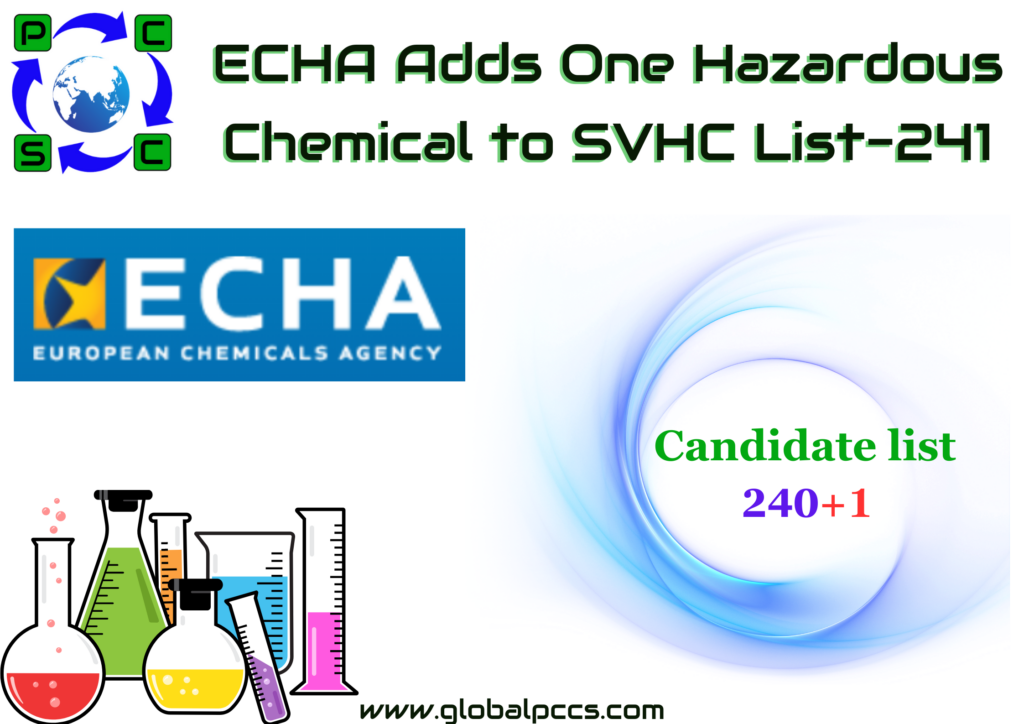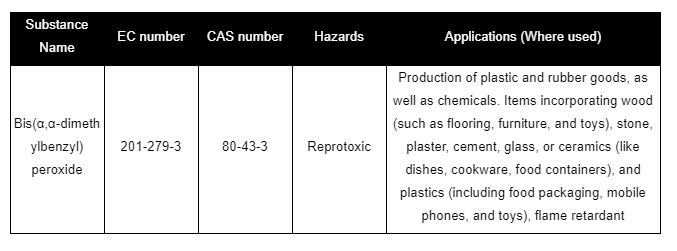 The European Chemicals Agency (ECHA) has announced one new REACH substances of very high concern (SVHC) that is possible to included to candidate list in June 27 2024
The European Chemicals Agency (ECHA) has announced one new REACH substances of very high concern (SVHC) that is possible to included to candidate list in June 27 2024
The 1 New Chemicals for a Total of 241 SVHC
EU REACH Obligations
The EU REACH regulation imposes various obligations on companies involved in the production, import, or use of chemical substances in the EU.
1. Registration: Manufacturers and importers must register substances they produce or import in one tonne or more per year. Registration involves providing information about the substance’s properties, uses, and potential hazards.
2. Evaluation: ECHA evaluates registered substances to ensure compliance with REACH requirements. This obligation includes assessing the safety of substances and verifying the completeness and accuracy of registration dossiers.
3. Authorization: Producers of certain SVHCs, including carcinogens, mutagens, and reproductive toxins, must apply to ECHA. Then, ECHA decides if they authorize these substances, subject to specified deadlines and conditions.
4. Restriction: REACH empowers the EU to restrict the manufacturing, placing on the market, or use of substances posing unacceptable risks to human health or the environment. Restrictions may include bans on certain substances or their use in specific applications.
5. Communication: Companies must communicate information on hazardous substances throughout the supply chain. This requirement includes providing safety data sheets (SDS) to downstream users and consumers and notifying ECHA of substances of very high concern (SVHCs) present in articles.
6. SVHCs: ECHA maintains a Candidate List of SVHCs based on their hazardous properties. Companies must notify ECHA when their products contain SVHCs above specified concentration thresholds and provide safe use information to recipients. See above for more details.
7. Duty to Substantiate Safe Use: Manufacturers and importers must ensure that the substances they place on the market are safe when customers use them. As a result, they may have to conduct chemical safety assessments and implement risk management measures. SDS plays an important role here.
The Candidate List now contains 241 entries for chemicals that can harm people or the environment. Companies are responsible for managing the risks of these chemicals and giving customers and consumers information on their safe use.
On June 27, 2024, ECHA’s Member State Committee (MSC) confirmed the addition of one hazardous chemical to the Candidate List of substances of very high concern (SVHC). The list now contains 241 entries, some of which are groups of chemicals so the overall number of impacted chemicals is higher.
The substance may be placed on the Authorisation List in the future. Companies need to apply for authorisation to continue the use once they are on that list.
The newly added chemical, bis(α,α-dimethylbenzyl) peroxide, is toxic for reproduction and is used as a processing aid, e.g. as a flame retardant.

The List of 241 SVHC
First, ECHA maintains the Candidate List of SVHCs under the REACH regulation (Registration, Evaluation, Authorization, and Restriction of Chemicals). Further, the Candidate List is regularly updated (every six months) with substances meeting the criteria for identification as SVHCs, which may include substances posing risks to human health or the environment.
What are the 241 SVHC?
As discussed above, SVHC stands for “Substance of Very High Concern.” SVHCs are chemical substances that experts identify as potentially posing a risk to human health or the environment within the European Union (EU). SVHCs are subject to regulatory scrutiny to be part of the Candidate List maintained by ECHA under the REACH regulation.
Scientists identify chemicals as SVHCs for various reasons, including:
- Carcinogenic, mutagenic, or toxic to reproduction (CMR) properties.
- Persistence, bioaccumulation, and toxicity (PBT) characteristics.
- Endocrine-disrupting properties.
- Concerns regarding similar severe effects on the environment or human health.
What Happens When an SVHC is on the Candidate List?
Once a substance appears in the Candidate List as an SVHC, it may eventually be subject to authorization, restriction, or other regulatory measures under REACH. Companies must communicate information about SVHCs in their products along the supply chain and may have specific obligations related to SVHCs depending on their use and concentration. For example, SVHCs above a threshold of 0.1% in every component of an article must appear on the public SCIP database. Consequently, millions of articles containing SVHCs appear on the SCIP database.
- Provide SDS to downstream if the concentration of SVHC on its own or in preparations exceeds 0.1%
- Provide safety use instruction to downstream recipients if the concentration of SVHC in products exceeds 0.1%. This equivalent information should be supplied to consumers within 45 days when requested
EU manufacturers, importers or only representative (OR) of SVHC shall notify ECHA if:
- The substance is present in those articles in quantities totalling over one tonne per producer or importer per year;
- The substance is present in those articles above a concentration of 0.1 % weight by weight (w/w).
In addition, starting from January 5, 2021, companies that have products containing more than 0.1% of SVHC are required to submit notifications through ECHA’s substances of concern in products (SCIP) database.
Conclusion:- Compliance with REACH is crucial for ensuring the safe production, use, and trade of chemicals in the European Union while protecting human health and the environment. Additionally, non-compliance with REACH obligations can result in penalties and legal consequences for companies.








 Authorised IMDS & CDX Training & Consulting partner for
Authorised IMDS & CDX Training & Consulting partner for





